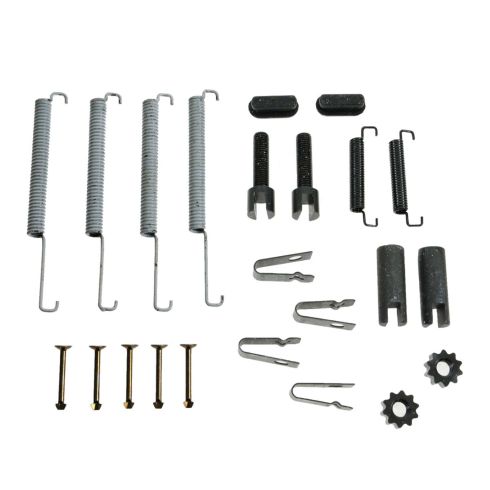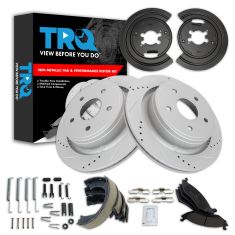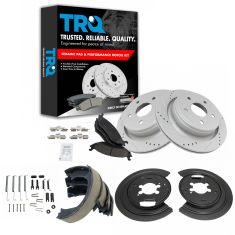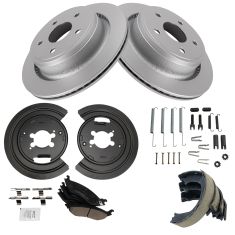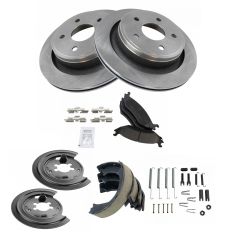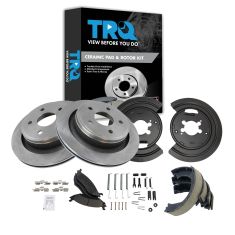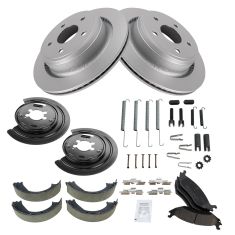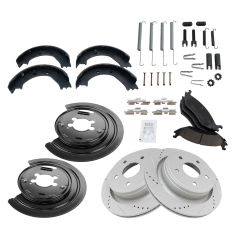Brought to you by 1AAuto.com, your source for quality replacement parts and the best service on the Internet.
Hi, I'm Mike from 1A Auto. I hope this how-to video helps you out, and next time you need parts for your vehicle, think of 1AAuto.com. Thanks.
In this video we are going to show you how to install or replace the parking brake shoes and hardware in this 2008 Dodge Ram 1500. This one's a 2008, but the procedure is pretty much the same for 2007 to 2010 Dodge Ram 1500s, excluding mega cabs.
You'll need a new parking brake shoe and a hardware kit from 1AAuto.com, twenty one and twenty two millimeter sockets with a ratchet and extension, breaker bar, chisel, hammer, locking, needle nose pliers, flat blade screwdriver, wire brush, brake cleaner, brake grease, torque wrench, a jack, and jack stands.
Put the vehicle on the ground. Using a twenty two millimeter socket and breaker bar, break the lug nuts for your wheel loose. These chrome lug nuts tend to be swollen, so make sure your socket's on there good. Once your lug nuts are loose, raise and support the vehicle with a jack and jack stands. This wheel and tire assembly, being a big off-road tire and twenty-inch wheel, it's going to be really heavy, so we're only going to bring it up a little bit when we take it off. Remove the wheel and tire from the hub.
Remove the caliper carrier and caliper as an assembly using a twenty one millimeter socket and breaker bar. Remove the caliper bracket and caliper. Secure it out of your way using a bungee cord.
Our rear rotor is frozen onto the hub in the rear axle. You'll want to make sure that your E-brake shoes are spun down if they are contacting the inside of the rotor. In this case, ours aren't touching, so we're going to hit the sides to free the inner brake shoes from the hat of the rotor as well as the front to free it from the hub being careful not to hit and damage the studs. While hitting it head on might seem counterproductive, the shock will break all the rust loose around the center and the wheel studs.
Remove the two clips securing the E-brake shoes onto the retaining pins. We're going to use the chisel and the hammer to try to tap them up and off of the pins. Using a pair of needle nose vice grips, latch on to the lower spring. You want to get on there nice and tight, because these are under some tension. Try and hold the shoe into place and release the hook of the spring from the bottom of the shoe. Use the same process to remove the larger front spring at the top. We don't have to fully remove that as long as it's disconnected for right now to take that tension off.
Spread the E-brake shoes and remove the adjuster wheel. Pry off the shoe from the mechanism at the top. You want to try to get it off and forward. Wiggle that out of the spring. Remove the opposite side. The springs get a little bit hung up there on the way up.
Here we have our old parking brake shoes and hardware that we removed from the truck and our new parts from 1AAuto.com. As you can see, all of our parts are exactly the same. We have some longer ears on the adjuster that aren't going to affect anything, as well as some different retaining clips to hold the shoes down onto the backing plate. Also, not a big deal, just a different style. They are still the same dimensions and will go right in.
Be sure when installing the new E-brake shoes the larger groove is on the bottom. This groove and the half-moon slot sit into the top. While there is a top and bottom to these shoes, there is no front and rear.
We're going to hook through our spring from the front here this spring sits on the rear. You're going to want the long end of the spring to sit forward toward the front of the truck. I'm going to set our brake shoes over the hub. Pry out and reinstall them onto the mechanism at the top. The spring that faces out toward us is going to go in the same way with this longer part of the spring going toward the front of the truck. Sits into the same grooves as the one we have just installed on the rear. Get on there nice and tight with your pair of needle nose vice grips. Quite a bit of tension on these. You may only get it set part way on there, at which point you'll just want to use like a pry bar. Just pop it in into the channel.
Spread the bottom of the brake shoes, and install the adjuster as you see here with the star wheel facing the front of the truck. Be sure that it sits fully into the large groups at the bottom. Install the lower spring as you see here. Hook one side in. Set the other end into place with your needle nose vice grip. Again, you may only get this to install partially, at which point you'll want to use the end of your grip or screwdriver to pop the hook into place.
We're going to install these retaining pins into the back of the backing plate, so it's just going to be a little difficult for you to see once it's in the vehicle. You're going to set these over the pin. Press down on the end of this spring clip and rotate it ‘til the pin locks into that groove. There's a small hole here in the back of the backing plate as well as on the opposite side where we'll install our retaining pin through there and through the corresponding holes in our brake shoe. You're going to want to get your finger to hold that in place. Send the spring clip in and lock it down onto the other side. Repeat this step on the opposite side.
Using the small wire brush, remove any surface rust and scaling from the hub and the hub center before reinstalling your rotor to make sure that it sits on there flat and doesn't rust back on to the hub.
Install your rotor onto the hub backwards and spray it down with some brake parts cleaner. This will remove the Cosmoline coating that's put on brake rotors at the factory to keep them from rusting in storage. Be sure to get the inner edge here, because that's where our parking brake shoes are going to ride. Put some brake grease onto the tip of your finger and coat the contact surface of the hub. Be sure to keep this grease off of the threads on your studs, otherwise it can affect your wheel torque when we reinstall the wheel. Just a thin coating is fine. This is just to keep corrosion from building up to make sure that our brake rotor comes off easily next time we have to replace our brakes.
Carefully install your rotor, and clean that surface down with some more brake parts cleaner. Put your truck in neutral and make sure that the rotor spins freely. Ours is going to have a little bit of resistance to it because we have what's called the positive traction rear end, which locks the axles together and keeps both rear tires in the truck turning together. While it does take a little bit of force to move, it moves nice and smooth and you can hear a very light dragging of the parking brakes shoe against the inside of the rotor, which is just how we want it. If you do have to adjust your E-brake up for whatever reason, the star wheel that we installed on the bottom can be accessed through this rubber plug, which you can remove from the back. That will allow you to rotate it to push the brake shoes out closer to the inside of the rotor as necessary.
Remove whatever you used to secure your brake caliper and carrier assembly out of the way. Slide it back onto the rotor. Reinstall your two twenty-one millimeter bolts into the caliper bracket. You can use the socket and ratchet if you need to to get them down tight. Ours is going in nice and smooth by hand, so we'll just bottom them out and tighten them. Its a hundred foot pounds with twenty-one millimeter socket and torque wrench.
Start your lug nuts by hand. Tighten the lugs as far as you can. Remember to bring the wheel down evenly and always tighten in a cross pattern. Once the lugs are as tight as you can get them with the tire in the air, put partial weight of the vehicle on the ground by lowering it off your jack stands. Torque your lug nuts to a hundred and thirty five foot pounds in a cross pattern.
Thanks for tuning in. We hope this video helped you out. Next time you need parts for your car, please visit 1AAuto.com. Also check out our other helpful how-to and diagnosis videos.
